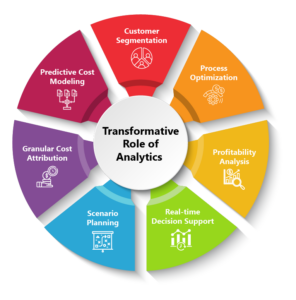Unlocking Value through Analytics: The Cost to Serve Analysis
In today’s hyper-competitive business landscape, understanding and optimizing the “Cost to Serve” is not just a financial imperative; it’s a strategic necessity. Cost to Serve represents the cumulative expenses an organization incurs to deliver a product or service to a customer. It encompasses everything from manufacturing and logistics to customer support and after-sales services. While traditionally viewed as a finance and operations metric, its significance extends far beyond the balance sheet. In the age of analytics, Cost to Serve analysis offers a transformative opportunity to make data-driven decisions that drive efficiency, enhance customer experiences, and ultimately boost profitability.
The Cost to Serve Ecosystem
The Cost to Serve ecosystem is intricate and multi-dimensional. It comprises various cost elements, including production costs, transportation expenses, inventory carrying costs, and customer service expenditures. Understanding the holistic picture requires the aggregation and analysis of data from diverse sources across the organization.
Challenges of Traditional Approaches
Historically, Cost to Serve analysis relied on manual calculations and aggregated cost data. While effective to a certain extent, this approach often lacked granularity and agility. It couldn’t keep pace with rapidly changing market dynamics or provide insights into cost drivers at a granular level.
Analytics’ Transformative Role
This is where analytics emerges as a game-changer. Advanced analytics, powered by machine learning and AI techniques, can dissect Cost to Serve at a micro-level. Here’s how analytics adds value:
Granular Cost Attribution
Analytics can precisely attribute costs to specific products, customers, or transactions. This granularity enables organizations to understand which products or customers are more cost-intensive and make informed pricing or resource allocation decisions.
Predictive Cost Modeling
By harnessing historical data and machine learning algorithms, organizations can create predictive cost models. These models can forecast future Cost to Serve based on different scenarios, helping companies proactively manage costs and mitigate potential risks.
Customer Segmentation
Analytics can segment customers based on their Cost to Serve profiles. This segmentation enables organizations to tailor their service levels and pricing strategies, ensuring that high-value customers receive premium service without significantly impacting costs.
Process Optimization
Analytics identifies bottlenecks and inefficiencies in the supply chain and customer service processes. With these insights, organizations can streamline operations, reduce costs, and improve service quality.
Profitability Analysis
Cost to Serve analysis coupled with analytics can unveil the true profitability of products or customer segments. This understanding allows companies to optimize their product mix, pricing strategies, and resource allocation.
Real-time Decision Support
Advanced analytics provides real-time insights into Cost to Serve. Organizations can monitor cost fluctuations as they happen, enabling immediate corrective actions.
Scenario Planning
Analytics facilitates “what-if” scenario planning. Organizations can simulate the impact of different strategies on Cost to Serve, helping them make informed decisions about investments or changes in their business model.
The Road to Data-Driven Decisions
The journey toward data-driven Cost to Serve analysis begins with data collection, integration, and quality assurance. With a robust data foundation, organizations can implement analytics solutions that cater to their specific needs.
Conclusion
In today’s data-driven era, the Cost to Serve is not just an accounting metric; it’s a strategic lever for organizations seeking to gain a competitive edge. Advanced analytics, with its ability to provide granular insights, predictive capabilities, and real-time decision support, is revolutionizing Cost to Serve analysis. It empowers organizations to optimize operations, enhance customer experiences, and boost profitability. To remain competitive and agile, organizations must embrace the transformative potential of analytics in their Cost to Serve strategies. Those who do will be well-positioned to thrive in an ever-evolving business landscape.

Zakir Ulla
A Technology and consulting leader with more than 18 years of IT and business advisory experience building and directing data-driven products and services across Fortune...Read More

Don’t miss our next article!
Sign up to get the latest perspectives on analytics, insights, and AI.







